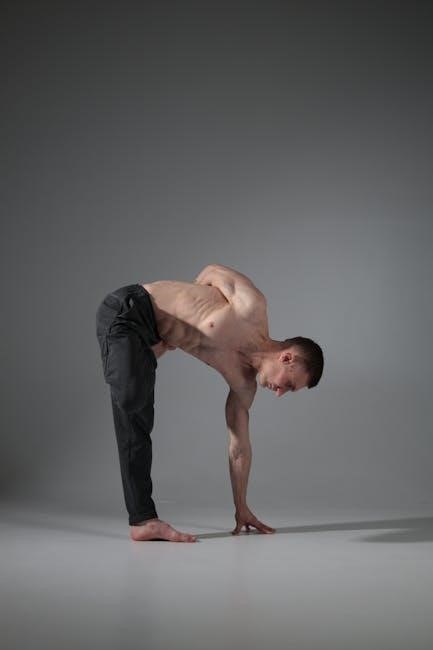
buteyko breathing technique pdf
The Buteyko Breathing Technique, developed in the 1950s by Dr․ Konstantin Buteyko, is a natural, non-invasive method that focuses on nasal breathing and controlled breath patterns․
It aims to improve respiratory health, reduce asthma symptoms, and enhance overall well-being by slowing breathing rates and increasing carbon dioxide levels in the blood․
Practiced globally, this technique promotes relaxation, improves oxygen delivery, and helps manage conditions like anxiety, sleep apnea, and chronic fatigue through mindful breathing exercises․

What is the Buteyko Breathing Method?
The Buteyko Breathing Method is a holistic approach to health developed by Dr․ Konstantin Buteyko in the 1950s․ It focuses on retraining breathing patterns to improve respiratory function and overall well-being․
By emphasizing nasal breathing and reducing hyperventilation, the technique aims to normalize carbon dioxide levels in the blood, which are crucial for proper oxygen delivery to tissues․
The method involves specific exercises to slow breathing rates and promote relaxation, helping to address conditions like asthma, anxiety, and chronic fatigue․ It is a natural, non-invasive practice that encourages mindful breathing for better health outcomes․

History and Development of the Buteyko Breathing Technique
The Buteyko Breathing Technique was developed in the 1950s by Dr․ Konstantin Pavlovich Buteyko in the Soviet Union, evolving from his research on respiratory physiology and human health․
Initially met with skepticism, the method gained acceptance as its benefits became evident, leading to its global adoption as a natural approach to improving breathing and overall well-being․
Dr․ Konstantin Pavlovich Buteyko and His Discovery
Dr․ Konstantin Pavlovich Buteyko, a Ukrainian physician, developed the Buteyko Breathing Technique in the 1950s while researching respiratory physiology and human health in Moscow․
His groundbreaking discovery stemmed from observing that people with respiratory disorders often breathed excessively, leading to hyperventilation and reduced carbon dioxide levels in the blood․
Buteyko’s work initially faced skepticism but gained recognition as his method demonstrated significant improvements in asthma and other respiratory conditions through controlled breathing exercises and nasal breathing practices․
His research also extended to studying breathing patterns in cosmonauts, further refining his understanding of optimal respiratory function and its impact on overall health․
Core Principles of the Buteyko Breathing Technique
The Buteyko method emphasizes nasal breathing, controlled breath patterns, and avoiding hyperventilation․ It focuses on restoring normal breathing rhythms and maintaining optimal carbon dioxide levels for better health․
Nasal Breathing and Its Importance
Nasal breathing is a cornerstone of the Buteyko Breathing Technique, as it ensures air is naturally filtered, warmed, and humidified before reaching the lungs․
This method promotes slower, more efficient breathing, reducing hyperventilation and preserving carbon dioxide levels, which are crucial for proper oxygen delivery and overall respiratory health․
The Role of Carbon Dioxide in Breathing
Carbon dioxide plays a crucial role in breathing as it helps regulate oxygen delivery to cells through the Bohr effect, ensuring efficient oxygen utilization․
The Buteyko method emphasizes maintaining optimal carbon dioxide levels by avoiding hyperventilation, which can expel too much CO2 and impair oxygen release to tissues․
By slowing breathing and promoting nasal breathing, the technique helps retain carbon dioxide, enhancing oxygen delivery and improving respiratory health, particularly for conditions like asthma․
Benefits of the Buteyko Breathing Technique
The Buteyko Breathing Technique offers numerous health benefits, including reduced asthma symptoms, improved oxygen delivery, and enhanced overall well-being․
It helps alleviate respiratory issues like wheezing and coughing while promoting relaxation and stress reduction․
Regular practice can improve blood circulation, boost energy levels, and support mental clarity․
This natural, non-invasive method is also known to aid in managing anxiety, insomnia, and chronic fatigue․
By optimizing breathing patterns, it enhances physical and mental health, making it a valuable tool for holistic well-being․
Improvement in Asthma and Respiratory Conditions
The Buteyko Breathing Technique has shown significant promise in managing asthma and other respiratory conditions by reducing symptoms like wheezing, coughing, and shortness of breath․
By promoting nasal breathing and slowing down the breath rate, the technique helps maintain optimal carbon dioxide levels, which can prevent bronchial constriction․
Studies indicate that regular practice can decrease the reliance on asthma medications, improving quality of life for sufferers․
Its focus on controlled breathing exercises also helps stabilize airway function, making it easier to manage chronic respiratory issues effectively․
This method is particularly beneficial for those seeking a drug-free approach to better respiratory health․
Enhanced Overall Health and Well-being
The Buteyko Breathing Technique not only improves respiratory health but also enhances overall well-being by promoting relaxation, reducing stress, and increasing energy levels․
Regular practice can lead to better sleep quality, improved mental clarity, and a reduction in anxiety and fatigue․
By optimizing breathing patterns, the technique helps balance the body’s physiological processes, leading to enhanced physical and mental health․
Many practitioners report improved emotional resilience and a greater sense of calm, making it a holistic approach to overall wellness․
This method empowers individuals to take control of their health, offering a natural and sustainable way to achieve long-term well-being;

How the Buteyko Breathing Technique Works
The Buteyko Breathing Technique involves controlled breathing exercises focusing on nasal breathing and conscious breath regulation to stabilize carbon dioxide levels and improve respiratory efficiency naturally․
Controlled Breathing Exercises
Controlled breathing exercises are central to the Buteyko method, aiming to normalize breath patterns by slowing down breathing to 8-12 breaths per minute․ These exercises involve nasal breathing and diaphragmatic engagement, helping to reduce hyperventilation and restore carbon dioxide balance․ They are typically practiced for 10-20 minutes daily and are designed to become automatic over time with consistent practice․ The exercises not only improve respiratory function but also promote relaxation and reduce stress, making them beneficial for overall health and well-being․
The Control Pause (CP) Test
The Control Pause (CP) Test is a simple, non-invasive assessment used in the Buteyko Breathing Technique to measure breath-holding time after a normal exhalation․ This test reflects the body’s tolerance to carbon dioxide and helps evaluate breathing efficiency․ A higher CP indicates better respiratory function and control․ The test is conducted at the start and end of breathing sessions to track progress․ It provides immediate feedback on how well the technique is being applied and helps practitioners adjust their exercises accordingly, making it a valuable tool for monitoring improvement in respiratory health and overall breathing patterns․
Scientific Evidence and Studies
The Buteyko Breathing Technique has been studied for its effectiveness in managing asthma, with trials showing reduced medication use and improved symptoms in respiratory conditions․
Research on the Effectiveness of the Buteyko Method
Studies have demonstrated the Buteyko Method’s efficacy in reducing asthma symptoms and improving quality of life․ Trials indicate decreased medication use and enhanced respiratory function in participants․
Studies on Asthma and Other Respiratory Conditions
Research highlights the Buteyko Method’s positive impact on asthma management, showing reduced symptoms and medication use․ Randomized controlled trials indicate improved lung function and quality of life in asthma patients․
- Studies demonstrate decreased reliever medication use and improved asthma control in both adults and children․
- The method has also shown benefits for conditions like chronic obstructive pulmonary disease (COPD) and sleep apnea․
- Case studies report reduced respiratory discomfort and improved oxygen delivery in individuals with chronic respiratory issues․
These findings suggest the Buteyko Technique as a valuable complementary therapy for managing respiratory health․

Practical Applications of the Buteyko Breathing Technique
The Buteyko Breathing Technique is practically applied through daily exercises, promoting nasal breathing and breath control, often combined with other therapies for enhanced respiratory health benefits․
Daily Breathing Exercises and Routine
Daily practice of the Buteyko Breathing Technique involves specific exercises to retrain breathing patterns, starting with a Control Pause (CP) test to assess current breathing efficiency․
Practitioners begin with gentle reduced breathing exercises, focusing on shallow breaths through the nose, often for 10-20 minutes, followed by another CP test to measure improvement․
Consistency is key, with routines typically performed in the morning and before sleep, emphasizing nasal breathing and relaxation to normalize breath rates and improve oxygen delivery․
Regular practice helps integrate the technique into daily life, enhancing respiratory function and overall well-being over time․
Use of the Buteyko Technique in Combination with Other Therapies
The Buteyko Breathing Technique is often used alongside other therapies to enhance treatment outcomes for respiratory and chronic conditions․
It complements yoga and pranayama practices by improving breath awareness and reducing hyperventilation․
In medical settings, Buteyko can be integrated with asthma medications to reduce reliance on inhalers and improve symptom control․
Some practitioners combine it with physical therapy to aid recovery from conditions like COPD and sleep apnea․
Additionally, Buteyko’s focus on nasal breathing and relaxation can support psychological therapies for anxiety and stress management․
This holistic approach allows individuals to address multiple health aspects simultaneously, promoting overall well-being․

Resources and Further Reading
Downloadable PDF guides and literature on the Buteyko Breathing Technique are widely available, offering detailed exercises and scientific research․
Certified practitioners can be found through official Buteyko associations, ensuring proper guidance and training in the method․

Recommended PDF Guides and Literature
Several comprehensive PDF guides detail the Buteyko Breathing Technique, offering step-by-step exercises, scientific insights, and practical tips for improving respiratory health․
Titles like “Buteyko Breathing Method” and “Buteyko Belt” provide in-depth instruction, while research papers and case studies, such as “Buteyko Breathing Technique for Asthma,” highlight its effectiveness․
These resources are available on official Buteyko websites, academic platforms, and online repositories, ensuring accessible learning for both beginners and advanced practitioners․
They often include testimonials, breathing exercises, and guidance on integrating the technique into daily routines for optimal health benefits․
Where to Find Certified Buteyko Practitioners
Certified Buteyko practitioners can be found through official Buteyko websites, professional directories, and global breathing associations․
Many practitioners offer sessions online or in-person, catering to diverse needs and locations․
Additionally, clinics like the Buteyko Clinic in Moscow and other accredited centers worldwide provide training and consultations․
Always verify credentials and reviews to ensure practitioners are qualified and experienced in the Buteyko method․